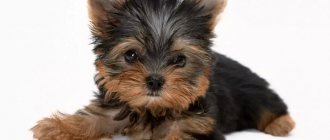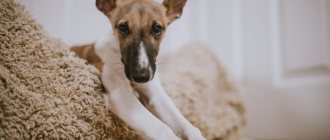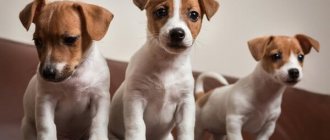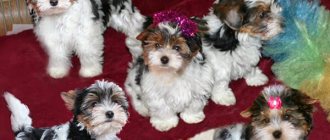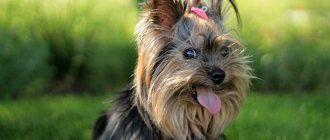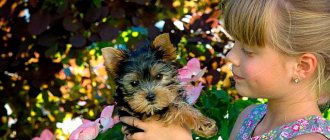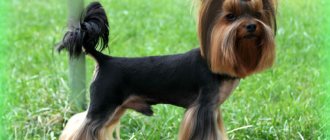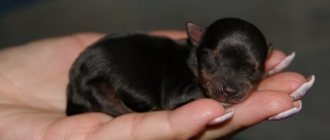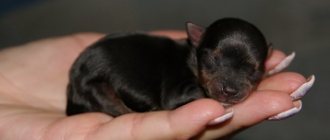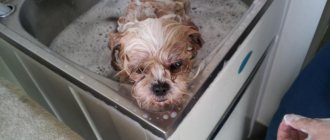Yorkshire Terriers are miniature toy dogs. The breed is very popular due to its charming appearance, small size and playful, friendly nature. Many people perceive these dogs as toys; they dress them up in dresses, do their hair, and carry them in their arms. But the Yorkie is a true terrier - energetic, courageous, loyal and intelligent. He requires not only care and affection, but also serious education. Before getting a dog of this breed, you need to study its description, character traits, pros and cons, and reviews from owners.
- Head
- Features of education and training
- Grooming
Breed traits
Breed traits (on a 5-point scale)
| Yorkshire Terrier | |||
| Activity | in the house | 3.8 | |
| on the street | 3.7 | ||
| Obedience | training | 2.9 | |
| strangers | 2.7 | ||
| Domination | in family | 2.1 | |
| over dogs | 2.8 | ||
| Defending your territory | from people | 2.7 | |
| from dogs | 3 | ||
| Sociability | in family | 4.8 | |
| with strangers | 3.7 | ||
| with dogs | 3.1 | ||
| Concentration | in family | 1.2 | |
| in front of strangers | 2.2 | ||
| with dogs | 2.1 | ||
| Aggressiveness | in family | 1.3 | |
| to strangers | 2 | ||
| to the dogs | 2.6 | ||
| to cats | 2 | ||
| Family behavior | calmness | 3.3 | |
| demand for affection | 4.2 | ||
| excitability | 3.8 | ||
| playfulness | 4.1 | ||
| excessive barking | 2.9 | ||
| behavioral breakdowns | 2.2 | ||
| Tolerance for children | up to 4 years | 3 | |
| over 4 years old | 3.7 | ||
| Institutional use | watchman | 3.6 | |
| bodyguard | 1.6 | ||
This breed is often compared to the following dog breeds: Jack Russell Terrier, Shih Tzu, Pug, Chihuahua, Miniature Poodle (Miniature Poodle).
Interesting photos of Yorkshire terriers:
Yorkshire Terrier
Yorkshire Terrier
Formation of Yorkie behavior and personality
The formation of the correct character and behavior of the Yorkshire Terrier occurs during the first three months of life of small puppies. A dog's temperament and personality largely depend on the behavior and training it receives during the first few months of its life. This is an important task that is usually performed by the breeder and if the owner gets the dog, no matter if it is younger or older than three months, he needs to continue with proper training because all the failures that you can see that the dog's behavior is due to ignoring and lack of proper care when the exact time has come for this.
General characteristics of Yorkshire Terriers
Yorkshire Terriers are small, energetic dogs with long, beautiful hair and a doll-like appearance. Many people get them as a decorative dog, a living toy. But this pet needs a lot of attention and care. Its long, silky fur, similar in structure to human hair, grows throughout its life. Therefore, it needs to be trimmed regularly and combed daily.
York is capable of becoming a devoted friend and faithful companion to all family members. Loves to play with children, accompany the owner on walks and travel. This is a smart, delicate, hardy dog. Suitable for older people, it can brighten up loneliness.
| Options | Characteristic |
| country of origin | Great Britain |
| weight | up to 3 kg |
| height | 18-20 cm |
| life expectancy | 13-16 years old |
| intelligence | very smart |
| aggressiveness | friendly |
| activity | average |
| training | easy to give in |
| need for care | tall, difficult to care for coat |
| attitude towards loneliness | can't stand it, they're very sad |
| security qualities | good |
pros
The Yorkshire Terrier is suitable for any person, even an inexperienced dog breeder, who is willing to pay attention to him. This dog has many advantages:
- the small stature of Yorkshire terriers allows you to have such a pet in a small apartment;
- can be carried in your arms or taken with you on a trip;
- due to the absence of undercoat and special structure, the wool does not cause allergies, there is no shedding;
- these dogs are loyal and loyal;
- cute, cheerful and good-natured;
- get along well with children and other pets, provided they grew up together;
- they have a beautiful appearance, they can do their hair, dress them up;
- they are smart, quick-witted, independent;
- are easy to train;
- clean, do not smell like dogs;
- you can be toilet trained at home using a diaper, you don’t have to take them for walks regularly;
- a good guard, boldly rushes to protect the owner;
- Compared to other decorative breeds, Yorkies are more resilient, active and healthy.
Minuses
But the Yorkshire Terrier is not a pet for everyone. You shouldn't get one if you don't have time to care for and communicate with the dog. There are not many disadvantages of the breed, but you also need to know about them before deciding to buy a puppy. Yorkshire Terriers:
- They cannot stand loneliness, they are very sad without their owner;
- require complex coat care, they need to be cut and bathed frequently - 2-3 times a month, using special cosmetics;
- cunning, independent, energetic, without proper upbringing they turn into a spoiled child;
- have low self-esteem, with frequent punishment they develop complexes and develop bad habits;
- prone to neurasthenia, timidity, and prone to stress;
- due to sensitive digestion, they need carefully selected feeding;
- in harsh climatic conditions, they require mandatory warm clothing;
- are not able to survive without a person, so a subcutaneous chip or address tag is needed.
The video will tell you about the pros and cons of these dogs:
Interesting Facts
The breed appeared a little over a century ago. Since the second half of the 20th century, it has been constantly in the top ten most popular. There are many interesting facts about these dogs.
- Yorkies were previously used as rat catchers. Modern dogs retain the hunting abilities of terriers.
- Despite their small size, Yorkshire Terriers are brave defenders. They are ready to protect their owner from any enemy. This is a terrier, he can attack even a large animal if he senses danger.
- The most famous Yorkie is Smokey, who accompanied and helped an American soldier during World War II.
- Often these dogs make sounds similar to grunting. This is a reaction to dust, different odors, pollen.
- Yorkies' fur grows throughout their life. Therefore, they require regular haircuts.
- The smallest dog in the world was Yorkie Sylvia. Her weight is 113 g and her height is just over 6 cm. She lived in the middle of the 20th century. Among modern records, the Yorkie Big Boss is registered with a height of 11.9 cm and a weight of 500 g.
- Puppies are born with black fur. With age, it brightens and acquires a standard reddish-gray color.
Reviews from Yorkie owners
“We almost gave ours to Jerry because he described literally the whole house. At first they thought that he would grow up and understand, but from the age of 8 months he began to specifically mark the corners. After he peed on my pillow, I took him to be castrated (the young man was against it, otherwise I would have done it earlier). That helped! Well, you need to walk 3 times a day, no less. When the doctor found out that Jer had been casting on his legs, soft toys, and in general on everything that moved, he said that castration was indicated for medical reasons - to prevent prostatitis.”
“My Yorkie became the first dog in my life. It takes a lot of time, but I haven’t regretted for a second that I adopted a puppy of this particular breed. He runs around faster than the most active Jack Russell, he loves me selflessly, and I love him. If you love, then no worries are a burden.”
“I wash my show dogs every week, and groomed ones once a month. There is no dog smell. I have them in a diaper, I think this is a huge advantage of the breed. Yorkies are welcome in any hotel, they are a great companion, and they don’t shed at all!”
“Our Count is 5 years old, we are cutting his hair to zero. He’s not picky about food, but we walk around in clothes. He got used to it quickly, he has a whole wardrobe for any occasion. On the street he loves to run and bark, the problem is that he cannot stand large dogs - he rushes at them. He may even rush at a child if he is running and screaming. We only walk on a leash. He idolizes my husband, but I, the service staff, take him for a walk, feed him, take him for vaccinations.”
“I cannot express how many positive emotions there are from such a miracle. After the death of our German, I thought I would never get a dog. But the children brought a Yorkie puppy, so they couldn’t put him outside the door. Lyalka has grown up affectionate and mischievous, lifts my spirits, and makes ropes out of her husband. If only I never got sick.”
History of the origin of the Yorkshire Terrier breed
Yorkshire Terriers are a breed developed in Great Britain. Ordinary peasants were engaged in their breeding. They were forbidden to keep large dogs so that they would not hunt in the lands of the rich. Small terriers were valued for their working qualities. They hunted rats in houses and farms, protected crops from birds, and helped miners.
At first they were called "Scotland Terrier" or "Dwarf Terrier". It is currently unknown which breeds were used for breeding. Experts believe that the ancestors of Yorkies were Skye Terriers, Waterside Terriers, Skye Terriers, Paisley Terriers and Manchester Terriers. Then the Maltese dog was probably used for selection, as indicated by the silkiness of the coat.
Small active dogs with long, beautiful hair were noticed by dog breeders at the end of the 19th century. They were presented at an exhibition in 1861. These dogs quickly became popular among the nobility, taking their place as pets. Representatives of the breed of that time were larger, weighing up to 7 kg. After 9 years, the breed was officially recognized, and in 1874 it received the name York Terrier.
At first, these dogs were bred only in the UK and the USA. But since the middle of the 20th century, the breed quickly spread throughout the world. The first Yorkshire Terrier appeared in Moscow in the 70s. By the end of the 20th century, nurseries appeared, and the breed became one of the ten most popular.
Interesting old images and historical photos of Yorkies:
Errors in parenting
Often, inexperienced dog breeders make serious mistakes when raising an Erka:
- They behave inconsistently and do not show proper persistence.
- They talk to the pet as if it were a person, instead of giving commands clearly and briefly.
- Classes are taking longer.
- They praise or punish not immediately after the act, but after some time.
- They do not take into account the individual characteristics of the puppy.
- Stop classes after completing the training course.
- They punish physically.
Description of appearance
The first breed standard was adopted at the end of the 19th century. But it changed several times, and took on its modern form in 1954. According to him, Yorkshire terriers are small dogs with long hair. They have a compact, graceful body, proportionally built, with a proud posture. They belong to the decorative breeds, according to the ICF classification - to terriers, to the toy terriers section. Varieties such as Biewer, Biro, Choco, Goldust, Micro and Chorkie are not recognized by the standard.
The size of these dogs is from 15 to 23 cm. The weight of the Yorkshire Terrier can be from 2.3 to 3.2 kg. Those dogs that participate in exhibitions should not weigh more than 3 kg. Varieties of mini and super-mini weighing up to 2 kg, which are popular in Russia, do not meet the standard and are not allowed for mating.
Head
The head is small and flat. The muzzle is moderately elongated. The bite is even, scissor-shaped. The ears are triangular in shape, set high and fairly close to each other, and should stand upright. The eyes are small, dark, with black eyelids. The expression is intelligent, attentive.
A common variety of Yorkies with a shorter muzzle and large protruding eyes. It's called a baby face. These dogs do not meet the standard, but they look cute, so they are popular.
Body type
The Yorkshire Terrier is built harmoniously and proportionally. The body is muscular, strong, but elegant. The neck is quite long, the ribs are not prominent, the back is straight. These dogs have a proud posture, despite their small size, they look important. The tail is heavily covered with hair; it used to be docked to medium length, but now this is rarely done. It should be straight, the dog holds it slightly above the line of the back.
Limbs
The limbs are smooth, straight, heavily covered with hair. The front legs are thin, the elbows are directed back and pressed to the body. The hindquarters are muscular and the hock joints are moderately pronounced. The paws are rounded, the claws are black.
Beautiful photos will complement the description of the Yorkie’s appearance:
Wool
The Yorkie's coat is often referred to as hair. She has a special structure, no undercoat and grows constantly. The coat is thin, silky, straight. If the dog is not trimmed, it hangs down on both sides of the body to the ground, separated by a straight parting on the back.
The coat should be shiny, not fluffy. It is long on the paws, tail, and head. So that the hair does not interfere with the dog's gaze, it is collected in a ponytail on the top of the head. They are often trimmed by doing different haircuts on their own or at grooming salons.
Colors
The Yorkshire Terrier has one color recognized by the standard. The color of the fur on the body ranges from black to silver-gray, usually steel bluish. On the head, paws and chest there are golden or reddish-brown shades. The hair is lighter at the ends and darker at the roots. The color is even, there should be no admixtures of other colors.
There are chocolate-colored Yorkies with black and white fur. These colors are not recognized by the standard. In such dogs, the coat may have an irregular structure - wavy, harsher.
Varieties
There are several varieties of Yorkshire Terriers. They are not recognized by all canine organizations and are often not allowed into exhibitions. These are mixed breed dogs or with slight deviations from the standard:
- Biewer is larger, with a developed undercoat, and the color is white, black or chocolate;
- Golddust is a fairly large dog with a strong skeleton and a stable psyche;
- biro with a small head, coat color includes golden, chocolate, white;
- mini – weight does not exceed 2 kg, less emotional;
- super-mini – weight up to 1.3 kg, good-natured and capricious, very painful
Photos show the types of colors and breed varieties of Yorkies:
Color variations
The breed standard stipulates the following color:
- from the back of the head to the base of the tail, the coat is steel-gray, but not silver, without red, bronze or dark hairs;
- the coat on the chest and paws is a rich golden brown color, darker at the roots;
- the hair on the head is golden brown, on the ears it is reddish-yellow-brown.
Non-standard but popular color variations include :
- Russian salon - coat of red shades, from wheat to red;
- black - Yorkies are completely black, without tan or inclusions of other shades;
- goldust – coat color of various shades of gold;
- chocolate – color varies from milk chocolate to dark chocolate color;
- biro - a coat of three colors: chocolate brown, white and golden.
Separately, we should mention the Biewer Yorkshire Terriers, which have black and white hair on the body and black, white and gold on the head.
NOTE!
Biewer Yorkies are not a variety of Yorkshire terriers, but a separate breed.
Personality of Yorkshire Terriers
The Yorkshire Terrier is a loyal, cheerful and intelligent pet. He is very sociable, loves to be the center of attention, but is not intrusive, he feels when he needs to step away. Therefore, it will be an ideal companion for an elderly person. This dog senses a person’s mood and tries to cheer him up.
These dogs become attached to all family members, but choose one owner, whom they obey, always accompany and sit on their laps. They love to play with children, supporting any fun. It is not recommended to have such a pet for families with a baby. If a child accidentally hurts the dog, it may bite.
York is a terrier, he is brave, decisive, and will always defend his owner, although there is no aggressiveness in his character. In the UK they say it is “a big dog in a small body.” These pets have the following character traits:
- friendly;
- devotees;
- affectionate;
- smart;
- emotional;
- fearless;
- delicate;
- independent;
- cunning;
- stubborn.
Features of education and training
The Yorkie is a dog that is easy to train, quickly masters simple commands, and understands not only words, but also the mood of a person. The main thing is to show who is boss in the house. Yorkies are terriers, they strive to dominate, so they require strict training from childhood. It is especially important to teach how to behave correctly on the street. They are curious, cocky, and can get playful and run across the road or attack another dog.
It is also necessary to socialize your pet from an early age. Yorkies are shy and afraid of noise, so you need to gradually accustom them to the sounds of the house, then to the sounds of the street. A well-mannered adult dog is not afraid of people, other animals, or the noise of cars, and travels calmly in public transport.
Some owners believe that the Yorkshire Terrier is an indoor pet, so it is not necessary to teach it commands. But without training, this dog can become uncontrollable, capricious, playful and brings a lot of problems. Therefore, training is still necessary. It is necessary to teach the commands “place”, “no”, “fu”, “to me”, “next to”, “sit”. These dogs easily understand “fetch”, “voice”, “fetch”, you can teach them agility or freestyle.
Due to his stubbornness and independence, training this dog can be challenging. These are restless, active dogs, so the training should not be long, you need to interest the pet, conduct classes in a playful way. Be sure to reward success with affection or treats. Yorkies should only be punished in a stern tone; they cannot be hit.
An interesting video will tell you about the need to train Yorkies:
Boy
Due to weak sexual dimorphism, a boy can be distinguished solely by his genitals.
Both sexes require a lot of attention from their owners. Yorkie men are less capricious than women. This is especially noticeable in cases where castration has been performed.
Sometimes boys try to establish themselves as the leader of the pack. This must be prevented immediately. You must become a leader for your pet from a very early age.
Care for Yorkshire Terriers
Yorkies are decorative pets and should be kept indoors. They do not tolerate cold and heat well, so they need clothing. At home, you need to give your pet a place away from drafts. These dogs love soft beds or houses. Be sure to buy a lot of toys so that the pet does not get bored in the absence of the owner.
Taking care of Yorkies is not easy due to their long hair. Although it does not shed, the dog will have to be brushed every day and trimmed once every 2-3 months. There are several other content features.
- Their eyes often become inflamed because their fur irritates them. Therefore, you need to collect your bangs in a ponytail. And wipe your eyes with boiled water or a special lotion.
- Yorkies have a tendency to develop tartar. You need to brush their teeth regularly with veterinary toothpaste.
- The nails of these dogs grow quickly, and even during long walks they do not wear down well. Therefore, they need to be trimmed several times a month.
- Like all small dogs, Yorkies often have clogged anal glands. This causes serious discomfort to the pet. Therefore, every few months they need to be cleaned by contacting a veterinarian or on your own.
Grooming
It is difficult to care for pets that are shown regularly. They grow fur; it requires washing with special shampoos and conditioners several times a week. It is treated with balsam, oil, and rolled into curlers. These dogs also require a visit to a groomer who knows how to properly trim a show pet's hair.
You can do your own haircuts for your pet Yorkie. Some owners greatly shorten the coat to make it easier to care for. Even if length is left on the body, it is necessary to trim the hairs on the paws, tail, and head, this will make it easier to care for and maintain cleanliness.
It is necessary to bathe the dog once every 1-2 weeks, otherwise an unpleasant odor appears and the coat takes on an unkempt appearance. It is also recommended to brush your pet daily to get rid of dead hair.
The video shows how to properly bathe a Yorkshire Terrier:
Nutrition
You can feed your Yorkies natural food or prepared food. Choose fresh products, be sure to eat meat, offal, cereals, vegetables, and dairy products every day. Food from the table, fatty and fried foods, smoked meats, sausages can be dangerous to a dog’s health.
When choosing ready-made food, you need to give preference to premium or super-premium class. It contains all the necessary microelements and a sufficient amount of protein. It must be intended for small breeds and must be age appropriate. You can feed your dog dry and wet food, alternating them. You can't buy good food inexpensively, but it will help keep your pet healthy.
It is important to understand how much food your pet needs. Yorkies should not be overfed; they are prone to obesity. After purchase, the puppy should be fed with the same food as the breeder provided. It is recommended to introduce a new type of diet gradually, over 2-3 weeks.
Health
If you create suitable conditions for Yorkies and feed them correctly, they live 15-16 years. The health of these dogs is relatively good; if they are vaccinated on time and treated for parasites, they get little sick. But these dogs are prone to injury. They are very active, love to jump higher, and get underfoot. Sometimes some congenital and acquired diseases also occur:
- joint pathologies, dislocations;
- breathing problems;
- decreased blood sugar levels;
- liver failure;
- retinal atrophy;
- dermatitis, neurodermatitis;
- cardiovascular pathologies;
- obesity.
Mini varieties are especially painful; they are weak, live less than standard Yorkies, and mating is undesirable for them.
Health problems
The lifespan of Yorkies is 14-16 years. During this time, dogs are characterized by good health and comparative problem-free behavior. Such statistics apply only to purebred animals that are examined for congenital diseases. Among the ailments often found in this breed are:
- ear diseases – occur due to hypothermia and owner’s oversight;
- inflammation of the mouth cavity, tartar - develop due to the special composition of saliva;
- slow change of teeth - molars grow against the backdrop of milk teeth that have not fallen out, as a result of which the correct bite deteriorates;
- indigestion - due to dental diseases and shortened intestines;
- fractures, ruptures and sprains of ligaments and tendons, dislocations - occur when falling from a height or unsuccessful jumps;
- necrosis of the femoral head, congenital dislocations, wedge-shaped vertebrae are genetic;
- umbilical hernia – congenital defect;
- ataxia is a hereditary disease manifested by weakness or complete lack of control of any muscle groups;
- obesity - often caused by the owner, who leaves the bowl full when leaving for work;
- hydrocephalus – is an accumulation of fluid in the cavity of the cranium.
How to buy a puppy
If you decide to get a dog of this breed, you need to choose the right kennel. A good breeder can be recommended by a veterinarian or friends, you can find him through reviews. It is not recommended to buy a puppy from advertisements. You can find a Yorkie on the Internet that is inexpensive, but this does not mean that it will be purebred.
In Moscow, a puppy with a pedigree costs 15-30 thousand rubles. A show-class dog will cost 50-60 thousand. Cheap puppies up to 15 thousand may have inconsistencies with the standard or genetic diseases.
Having chosen a kennel, you need to study the conditions of keeping the dogs and the documents of the parents. Puppies must have a veterinary passport and have received the necessary vaccinations by the day of sale. It is better to choose an active, non-cowardly child. It needs to be examined so that the eyes are clean, the coat is smooth without dandruff, and the tummy is not swollen.
When purchasing, the question often arises of which gender of puppy to choose. Yorkie males are more active and courageous. Bitches are affectionate and obedient. But problems may arise after mating, especially with small varieties.
The photographs show what Yorkshire terrier puppies should look like:
Yorkshire Terriers are decorative dogs. Even those who do not have the opportunity to walk their pet regularly can get them. He can go to the toilet in a diaper. The main thing is to pay attention to it and properly care for its coat. This dog is capable of becoming a devoted companion, watchman, and friend to a child.
Who is this dog suitable for?
If we take a comprehensive look at the positive and negative qualities of the Yorkshire Terrier dog, the characteristics of the breed indicate that the dog is definitely suitable:
- active people (Yorkies have irrepressible energy and need to move);
- for allergy sufferers (the mini terrier has hypoallergenic coat);
- people who love to care for their dog (combing, cutting, dressing);
- families with a growing child (terrier loves children's attention);
- large families (York will welcome attention from a large number of people).
The devotion of miniature terriers knows no bounds. The brave Yorkie is ready to protect his owner from troubles throughout his life - his emotional connection is so strong. It’s not without reason that they say that a dog is man’s best friend.
Breeding
Only healthy, purebred individuals are allowed to mate.
A girl's first heat begins at the age of 8-10 months. It is divided into two periods. During the first, dark, round droplets appear. During the second, they brighten. This indicates imminent ovulation. The estrus itself lasts up to 20 days.
The female is ready for her first mating at the age of 1.5 to 2 years. Mating is not allowed if the girl is over 8 years old.
Consider the weight of the animal. It should be 2-3 kilograms. With less weight, the bitch may not bear offspring.
Preparing individuals for breeding:
- Choose a couple in advance and introduce them.
- Give your pets all necessary vaccinations no later than a month before estrus.
- Get rid of worms from future parents.
- A week before breeding, wash and cut the dogs.
Pregnancy lasts 58-64 days. 2-3 weeks after conception, the mother begins to show symptoms of pregnancy: her nipples swell, her tummy becomes round, her appetite sometimes disappears, she becomes lethargic and sleepy.
The normal basal temperature of a bitch is 38.5°C. Immediately before the babies are born, the girl’s basal temperature will drop by 1-2 degrees. It will be 37-37.5°C.
Childbirth does not last long. If your bitch is giving birth for the first time, it is better to enlist the help of a veterinarian.
3-4 puppies are born at a time.
Photos of the puppies are presented below.
Nicknames
For boy
Popular names for male dogs:
- Aidan.
- Archie.
- Billy.
- Caden.
- Connor.
- Dylan.
- Ethan.
- Evan.
- Layam.
- Jack.
- Jackson.
- Small.
- Henry.
- Leo.
- Lucas.
- Logan.
- Matty.
- Nid.
- Noah.
- Ollie.
- Owen.
- Sammy.
For girl
Popular nicknames for girls:
- Abi.
- Aria.
- Bella.
- Brandy.
- Boni.
- Brookie.
- Callie.
- Chloe.
- Clara.
- Emma.
- Flory.
- Gracie.
- Anna.
- Izzy.
- Laura.
- Lexi.
- Liv.
- Lottie.
- Mia.
- Riley.
- Sarah.
- Sophie.
- Zoe.

